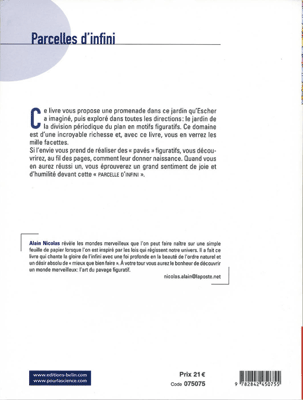
FIGURATIVE TESSELLATION
Among the disciplines that come from a mixture of Mathematics and Art, figurative tiling is the most fascinating of all, as there is something magical in seeing
complex identical forms assemble without leaving any gap in between them into infinity. This process requires imagination rather than artistic qualities or geometrical knowledge.
However, the use of the usual 17 symmetry groups in the plane in crystallography is complex and, historically, has been poorly adapted.
This is the reason why I had published "Parcelles d'infini" in 2005 in order to propose a method much better adapted in practice, simple and accessible to all, adults and children
alike. My book, published in 2005, is now out of print. Having recovered my author's rights, and at the request of many «tessellators», you can now find its full content, in French
and in English, under the heading "Tessellation Method". Using English from school (in the sixties!) and a not very good translator, let the readers be indulgent with my
translation.
My method use the 35 basic polygons (or so-called isohedral) that do not have rectilinear sides or central symmetry. The only necessary tools for creating objects, animals or human
beings are a pencil, an eraser and some paper. Many colourful tiling examples are illustrated throughout the nine chapters. A full chapter is also dedicated to tiling with words,
which is an idea never explored by Escher and others and up to the publication of my book in 2005.


It's important that artwork,
Just as woman have this gift:
Seduce at first glance,
And enthrall at second.
What does it matter if art is a lie, if it searches the truth;
What does it matter its limitations, if it aims eternity.
The substance needs the form to present itself to men,
the form needs the substance to present itself to God.
THE ART OF FIGURATIVE MATHEMATICAL TESSELLATION
Unlike pictorial art in general where too often you do anything, figurative tilings keeps you in the realm of universal natural order. No graphic art has these constraints which forces you to stay close to nature.
Every line you draw goes in this direction and you have to do it and repeat it until the perfection. You are not in control. You share your own requirements with those of the laws of the universe. You don't create.
You are only a revealer. And this is your art.
And because of its specificity to be infinitely reproducible, the figurative tessellation offers the most beautiful approach through imagination, of the absolute and eternity.
ARTIFICIAL INTELLIGENCE
Artificial Intelligence is now capable of drawing by imitating the style of the most famous artists, in all styles (impressionism, classicism, cubism, pointillism, surrealism, etc.). All of them? Well no! Not the one
where inspiration manifests itself through a rational work accessible to all: the art contrary to "anything goes", the art of which Escher is the most illustrious representative. And yet, you'd think that if AI is so
intelligent, it should, through superior thinking, surpass the artists who practice this art...Yes, but there you go, Einstein said: "The true sign of intelligence is not knowledge but imagination." Certainly, the machine
is formidable and has phenomenal knowledge, but where is the imagination? Well, this one, of course, belongs only to man, like inspiration, common sense, intuition, dreams... Yes, the dream of exploring the unknown to
discover new and marvelous concepts, yet with a mathematical logic.
Rest assured, dear readers, cerebral Art is far from being replaced by machines, and this is its grandeur and prestige.


 NICOLAS 2014
NICOLAS 2014
